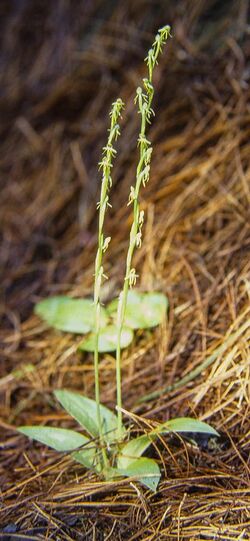Biology:Habenaria tridactylites
From HandWiki
Short description: Species of flowering plant
| Habenaria tridactylites | |
|---|---|

| |
| Scientific classification Error creating thumbnail: Unable to save thumbnail to destination
| |
| Kingdom: | Plantae |
| Clade: | Tracheophytes |
| Clade: | Angiosperms |
| Clade: | Monocots |
| Order: | Asparagales |
| Family: | Orchidaceae |
| Subfamily: | Orchidoideae |
| Genus: | Habenaria |
| Species: | H. tridactylites
|
| Binomial name | |
| Habenaria tridactylites Lindl.[1]
| |
Habenaria tridactylites, the Canary three-finger orchid, is a species of flowering plant in the family Orchidaceae, native to the Canary Islands. It was first described by John Lindley in 1835.[1]
Description
Habenaria tridactylites is a terrestrial orchid. The upper perianth segments form a "helmet". The lowest petal forms the lip, which is deeply divided into three very long lobes. The flower also has a long spur.[2]
Distribution and habitat
Habenaria tridactylites is endemic to the Canary Islands. In Tenerife, it is found on forested hillsides in the lower zone; in Gran Canaria, it occurs at elevations of 200–800 m; it also occurs in the other islands – La Gomera, La Palma, El Hierro, Lanzarote and Fuerteventura.[2]
References
- ↑ 1.0 1.1 "Habenaria tridactylites", World Checklist of Selected Plant Families (Royal Botanic Gardens, Kew), http://apps.kew.org/wcsp/namedetail.do?name_id=95768, retrieved 2018-02-01
- ↑ 2.0 2.1 Bramwell, David; Bramwell, Zoë (2001), Wild Flowers of the Canary Islands (2nd ed.), Madrid: Editorial Rueda, p. 413, ISBN 84-7207-129-4
External links
Wikidata ☰ Q2311465 entry
 |



